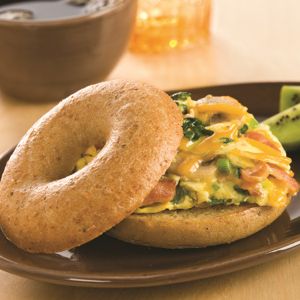Teaching Speed Scratch as Bakery Business Builder
01 April 2014
 To baking-and-pastry students with dreams of owning and operating their own bakeshops, whether to create from scratch or utilize a convenience-added product has everything to do with quality and consistency.
To baking-and-pastry students with dreams of owning and operating their own bakeshops, whether to create from scratch or utilize a convenience-added product has everything to do with quality and consistency.
By Mark Kwasigroch
Your mission: Make a batch of turnovers that are light, buttery and flakey. Do you …
One, commit to a multi-step process that includes preparing a base dough with bread flour and all-purpose flour, enclose butter at exactly the right temperature, chill rolled-out dough before rolling out again (then repeat), then cut, fill, fold and bake to consume literally hours for perfect turnovers?
Or two, lay out ready-to-use puff-pastry dough, cut into squares or circles, fill to make sweet or savory, crimp and bake for beautifully golden, fresh-from-the-oven turnovers in minutes?
Today, more American bakeshops (and even bakeshops in France) seek short-cut solutions to creating high-quality classic pastries, breads and other baked goods. This should come as no surprise; after all, the phrase “from scratch” entered the English lexicon as recently as the 1950s—the same decade that produced the first electric can opener. In an industry beleaguered by excruciatingly short profit margins and a dearth of qualified help, “speed scratch,” or the use of convenience products to eliminate time and labor in food preparation, makes a lot of sense.
Granted, nothing equals scratch. But scratch simply is not practical or reasonable in most operations that want to turn a profit in today’s environment.
In my role as a baking instructor at the Kendall College School of Culinary Arts in Chicago, I discuss “real world” bakeshop situations with my students as a matter of course, and I build working with convenience-added items into the curriculum. After all, Kendall wants to create skilled bakers and pastry chefs, but also successful managers and businesspeople. I instruct them the same way I helped bakeshops excel with Dawn products, by teaching that the objective is to fill holes on shelves—and to keep filling them, meaning items are selling.

These days, “convenience added” has largely replaced the term "speed scratch,” but the concept is the same: enlisting convenience food products in everything from components of more complicated dishes to simply thawing or heating, then serving. What’s changed from 1993 when the term “speed scratch” was coined by a Springfield, Mo.-based PR firm is chefs’ and bakers’ acceptance of using convenience-added products to get the job done. When nary a baker worth his or her salt would admit to cutting corners 25 years ago, the realities of the marketplace have made convenience products in professional bakeshops not only acceptable, but necessary.
The cincher is quality. Consider a croissant. A handful of respected manufacturers offer freezer-to-oven croissants that, while pricey, require absolutely no labor. But assuming some steps of production, while eliminating others, can award an operation that “from scratch” reputation without all the work and for less cost. For instance, although puff-pastry dough does not contain yeast, the water in the dough creates steam, which aids rising in the oven and creates some of the airiness of the traditional. And premium convenience puff pastry made with high-butterfat butter rather than margarine yields a desired mouthfeel and flavor experience that customers crave.
From One Base, Many Products
But don’t stop there. Explain to students that with the bulk of the work already done, in-store staff has the time and opportunity to take that turnover or croissant to the next level, creating value-added items warranting a higher price that customers are willing to pay and, thus, yielding greater profit. And with a good-quality puff pastry, croissants and turnovers are just the beginning. From that single product comes a host of other goods such as cream horns, napoleons, palmiers, allumettes and galettes, as well as sweet and savory bouchées and strudels.
If cutting time and labor weren’t enough, have students keep in mind that a single product with many uses greatly facilitates their inventory control, both for the walk-in and pantry.
I was once one of those classically trained bakers who spurned the thought of “speed scratch,” treating the idea like a four-letter word. When I worked for high-end hotels and bakeshops and later owned my own bakery, it was scratch or nothing. And I put in many long hours every day for many years.
But when I sold The Winnetka Pâtisserie located north of Chicago and joined Dawn Food Products, suddenly I was marketing convenience solutions—like bread mixes and bases, puff dough, scone and muffin mixes and even ready-to-ice cakes—to bakers just like me.
A good example is a 30-pound cake base that can be transformed into loaf cakes, ring cakes and muffins. Pour whole eggs into a mixing bowl and add base, a flavor extract or emulsion and poppy seeds. Blend and cream, gradually add oil and water, then blend again. Fill 1-pound loaf pans, 8-inch ring pans and/or muffin tins and bake to golden brown. Top with a premade (or scratch) streusel and/or sliced or slivered nuts, and voila! Three different baked goods, virtually as easy as pie—and nearly from scratch.
Why make your own pizza dough when pre-cut, pre-sheeted round and square dough is available in a huge range of sizes in white and wheat varieties? Students can make any pizza dough “better for you” by sprinkling on cooked whole grains like white, red or black quinoa (which also contributes quality protein). Simply thaw, proof, dock, top (or fill and roll) with any of a wealth of ingredients, and bake. Think calzones and other pocket sandwiches, as well as focaccia topped with grilled vegetables and an umami-rich cheese, and that pizza dough does double or even triple duty. Certainly, quality dough mixes for this purpose are abundant if students want even more of that “from scratch” look and feel.
Do you have students who excel at from-scratch breads? Then suggest that they devote their energy and focus to them when they have their own operations someday. Meanwhile, many excellent cake bases and mixes are so easy to prepare that the least-skilled staff can execute them, expanding the menu with consistent-quality cakes.
Indeed, always stress to students that the primary factor in choosing any convenience-added product is quality. If it tastes consistently as good, with the desired appearance and mouthfeel, as they would make from scratch, then they’ve found a superb partner in meeting their operational goals.
From cookies to scones, from pie shells to danishes, there’s a quality convenience-added product to meet every modern bakeshop need. The amount of “from scratch” students wish to incorporate has everything to do with their labor, facility and profit goals. Have them experiment with the wealth of products available, and select those that they feel will best build their operations’ hard-earned brand.
Mark Kwasigroch is a baking-and-pastry chef instructor at the Kendall College School of Culinary Arts, Chicago. For more information, visit www.kendall.edu.
Photo: Purchasing quality ready-to-eat bagels allows bakery owners to focus on producing scratch -baked goods that build an operation’s brand and reputation with customers. Courtesy of Rich Products Corporation